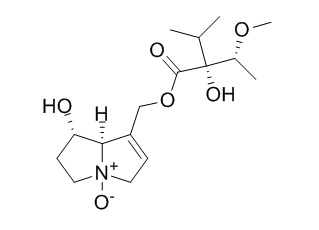Heliotrine N-oxide
Heliotrine N-oxide was used as an internal standard.
Inquire / Order:
manager@chemfaces.com
Technical Inquiries:
service@chemfaces.com
Tel:
+86-27-84237783
Fax:
+86-27-84254680
Address:
1 Building, No. 83, CheCheng Rd., Wuhan Economic and Technological Development Zone, Wuhan, Hubei 430056, PRC
Providing storage is as stated on the product vial and the vial is kept tightly sealed, the product can be stored for up to
24 months(2-8C).
Wherever possible, you should prepare and use solutions on the same day. However, if you need to make up stock solutions in advance, we recommend that you store the solution as aliquots in tightly sealed vials at -20C. Generally, these will be useable for up to two weeks. Before use, and prior to opening the vial we recommend that you allow your product to equilibrate to room temperature for at least 1 hour.
Need more advice on solubility, usage and handling? Please email to: service@chemfaces.com
The packaging of the product may have turned upside down during transportation, resulting in the natural compounds adhering to the neck or cap of the vial. take the vial out of its packaging and gently shake to let the compounds fall to the bottom of the vial. for liquid products, centrifuge at 200-500 RPM to gather the liquid at the bottom of the vial. try to avoid loss or contamination during handling.
Int J Mol Med.2019, 43(6):2516-2522
J Microbiol Biotechnol.2023, 33(10):1317-1328.
Exp Parasitol.2018, 194:67-78
Chemistry of Natural Compounds2020, 56,423-426
Molecules.2023, 28(19):6767.
EXCLI J.2023, 22:482-498.
Appl. Sci.2020, 10(5),1713.
Nutrients.2023, 15(6):1417.
Evid Based Complement Alternat Med.2021, 2021:5319584.
Molecules.2023, 28(8):3376.
Related and Featured Products
Biomed Mass Spectrom. 1980 Feb;7(2):65-73.
Direct quantitative analysis of indicine-N-oxide in cancer patient samples by gas chromatography using the internal standard heliotrine-N-oxide including a mass spectral comparison of their trimethylsilyl derivatives.[Pubmed:
7407334 ]
METHODS AND RESULTS:
Indicine-N-oxide was analyzed quantitatively in biological samples using a direct partial purification method involving acetonitrite precipitation or methanol precipitation followed by ion exchange chromatography. Trimethylsilyl derivatization of the resultant provided either of two derivatives, depending on the reaction conditions used, both of which had good gas chromatographic qualities. Heliotrine N-oxide was used as the internal standard for this work. Data are presented to show that this is a reliable and useful internal standard based on its behavior in the partial purification method and on the gas chromatographic characteristics of its two derivatives. In addition, both low and high resolution mass spectral data indicate that Heliotrine N-oxide produces two trimethylsilyl derivatives analogous to those produced by indicine N-oxide under the same conditions.
CONCLUSIONS:
Application of this procedure to urine and blood samples from cancer patients in clinical trials indicates that over 95% of the drug is removed from the circulation and excreted in the urine over the course of 48 h.
Food Addit Contam Part A Chem Anal Control Expo Risk Assess. 2013;30(10):1799-806.
Pyrrolizidine alkaloids: their occurrence in Spanish honey collected from purple viper's bugloss (Echium spp.).[Pubmed:
23886433]
The incidence and concentration of pyrrolizidine alkaloids (PAs) from Echium spp. plant have been defined in 103 Spanish honey samples.
METHODS AND RESULTS:
Each sample was examined to determine total pollen content, the percentage of Echium spp. pollen, and simultaneous measurements of PAs and their N-oxides concentrations by the HPLC-ESI/MS method to identify the potential origin of PAs in honey. PAs were found in 94.2% of the raw honey samples analysed, in the range of 1-237 µg kg(-1) (average concentration = 48 µg kg(-1)). The PA pattern was clearly dominated by echimidine, lycopsamine and their N-oxides, representing the 97.8% of total ∑PAs, and only echimidine and echimidine-N-oxide surpassed the 87% of total ∑PA content. Others PAs, seneciphylline and Heliotrine N-oxide, appear to be reported in a lower incidence and concentration (average of 3 and 1 µg kg(-1), respectively). The Pearson Chi-squared test (p ≤ 0.01) confirms the non-correspondence between pollen plants and PA content.
CONCLUSIONS:
This study was also realised to generate a dataset in order to evaluate the potential risk of Spanish honeys containing PA plants belonging to the genera Echium.



